A detailed study of Fixed-\(X\) and Model-\(X\) knockoffs
Lei Sun
2018-03-01
Last updated: 2018-05-12
workflowr checks: (Click a bullet for more information)-
✔ R Markdown file: up-to-date
Great! Since the R Markdown file has been committed to the Git repository, you know the exact version of the code that produced these results.
-
✔ Environment: empty
Great job! The global environment was empty. Objects defined in the global environment can affect the analysis in your R Markdown file in unknown ways. For reproduciblity it’s best to always run the code in an empty environment.
-
✔ Seed:
set.seed(12345)The command
set.seed(12345)was run prior to running the code in the R Markdown file. Setting a seed ensures that any results that rely on randomness, e.g. subsampling or permutations, are reproducible. -
✔ Session information: recorded
Great job! Recording the operating system, R version, and package versions is critical for reproducibility.
-
Great! You are using Git for version control. Tracking code development and connecting the code version to the results is critical for reproducibility. The version displayed above was the version of the Git repository at the time these results were generated.✔ Repository version: ddf9062
Note that you need to be careful to ensure that all relevant files for the analysis have been committed to Git prior to generating the results (you can usewflow_publishorwflow_git_commit). workflowr only checks the R Markdown file, but you know if there are other scripts or data files that it depends on. Below is the status of the Git repository when the results were generated:
Note that any generated files, e.g. HTML, png, CSS, etc., are not included in this status report because it is ok for generated content to have uncommitted changes.Ignored files: Ignored: .DS_Store Ignored: .Rhistory Ignored: .Rproj.user/ Ignored: analysis/.DS_Store Ignored: analysis/BH_robustness_cache/ Ignored: analysis/FDR_Null_cache/ Ignored: analysis/FDR_null_betahat_cache/ Ignored: analysis/Rmosek_cache/ Ignored: analysis/StepDown_cache/ Ignored: analysis/alternative2_cache/ Ignored: analysis/alternative_cache/ Ignored: analysis/ash_gd_cache/ Ignored: analysis/average_cor_gtex_2_cache/ Ignored: analysis/average_cor_gtex_cache/ Ignored: analysis/brca_cache/ Ignored: analysis/cash_deconv_cache/ Ignored: analysis/cash_fdr_1_cache/ Ignored: analysis/cash_fdr_2_cache/ Ignored: analysis/cash_fdr_3_cache/ Ignored: analysis/cash_fdr_4_cache/ Ignored: analysis/cash_fdr_5_cache/ Ignored: analysis/cash_fdr_6_cache/ Ignored: analysis/cash_plots_cache/ Ignored: analysis/cash_sim_1_cache/ Ignored: analysis/cash_sim_2_cache/ Ignored: analysis/cash_sim_3_cache/ Ignored: analysis/cash_sim_4_cache/ Ignored: analysis/cash_sim_5_cache/ Ignored: analysis/cash_sim_6_cache/ Ignored: analysis/cash_sim_7_cache/ Ignored: analysis/correlated_z_2_cache/ Ignored: analysis/correlated_z_3_cache/ Ignored: analysis/correlated_z_cache/ Ignored: analysis/create_null_cache/ Ignored: analysis/cutoff_null_cache/ Ignored: analysis/design_matrix_2_cache/ Ignored: analysis/design_matrix_cache/ Ignored: analysis/diagnostic_ash_cache/ Ignored: analysis/diagnostic_correlated_z_2_cache/ Ignored: analysis/diagnostic_correlated_z_3_cache/ Ignored: analysis/diagnostic_correlated_z_cache/ Ignored: analysis/diagnostic_plot_2_cache/ Ignored: analysis/diagnostic_plot_cache/ Ignored: analysis/efron_leukemia_cache/ Ignored: analysis/fitting_normal_cache/ Ignored: analysis/gaussian_derivatives_2_cache/ Ignored: analysis/gaussian_derivatives_3_cache/ Ignored: analysis/gaussian_derivatives_4_cache/ Ignored: analysis/gaussian_derivatives_5_cache/ Ignored: analysis/gaussian_derivatives_cache/ Ignored: analysis/gd-ash_cache/ Ignored: analysis/gd_delta_cache/ Ignored: analysis/gd_lik_2_cache/ Ignored: analysis/gd_lik_cache/ Ignored: analysis/gd_w_cache/ Ignored: analysis/knockoff_10_cache/ Ignored: analysis/knockoff_2_cache/ Ignored: analysis/knockoff_3_cache/ Ignored: analysis/knockoff_4_cache/ Ignored: analysis/knockoff_5_cache/ Ignored: analysis/knockoff_6_cache/ Ignored: analysis/knockoff_7_cache/ Ignored: analysis/knockoff_8_cache/ Ignored: analysis/knockoff_9_cache/ Ignored: analysis/knockoff_cache/ Ignored: analysis/knockoff_var_cache/ Ignored: analysis/marginal_z_alternative_cache/ Ignored: analysis/marginal_z_cache/ Ignored: analysis/mosek_reg_2_cache/ Ignored: analysis/mosek_reg_4_cache/ Ignored: analysis/mosek_reg_5_cache/ Ignored: analysis/mosek_reg_6_cache/ Ignored: analysis/mosek_reg_cache/ Ignored: analysis/pihat0_null_cache/ Ignored: analysis/plot_diagnostic_cache/ Ignored: analysis/poster_obayes17_cache/ Ignored: analysis/real_data_simulation_2_cache/ Ignored: analysis/real_data_simulation_3_cache/ Ignored: analysis/real_data_simulation_4_cache/ Ignored: analysis/real_data_simulation_5_cache/ Ignored: analysis/real_data_simulation_cache/ Ignored: analysis/rmosek_primal_dual_2_cache/ Ignored: analysis/rmosek_primal_dual_cache/ Ignored: analysis/seqgendiff_cache/ Ignored: analysis/simulated_correlated_null_2_cache/ Ignored: analysis/simulated_correlated_null_3_cache/ Ignored: analysis/simulated_correlated_null_cache/ Ignored: analysis/simulation_real_se_2_cache/ Ignored: analysis/simulation_real_se_cache/ Ignored: analysis/smemo_2_cache/ Ignored: data/LSI/ Ignored: docs/.DS_Store Ignored: docs/figure/.DS_Store Ignored: output/fig/ Unstaged changes: Deleted: analysis/cash_plots_fdp.Rmd
Expand here to see past versions:
| File | Version | Author | Date | Message |
|---|---|---|---|---|
| rmd | cc0ab83 | Lei Sun | 2018-05-11 | update |
| html | 4b179a9 | LSun | 2018-04-05 | Build site. |
| rmd | 20ea328 | LSun | 2018-04-05 | wflow_publish(c(“analysis/knockoff_7.rmd”, “analysis/knockoff_8.rmd”, |
| html | cb9d445 | LSun | 2018-03-11 | Build site. |
| rmd | 2c9cf26 | Lei Sun | 2018-03-11 | obser |
| html | d3d259c | LSun | 2018-03-10 | Build site. |
| rmd | b1215be | LSun | 2018-03-10 | wflow_publish(“analysis/knockoff_8.rmd”) |
| rmd | 4c3a79f | Lei Sun | 2018-03-05 | Sign |
| rmd | 459d383 | LSun | 2018-03-05 | W.sign |
| rmd | eb23c68 | Lei Sun | 2018-03-04 | rerun |
| rmd | af8b170 | Lei Sun | 2018-03-03 | model x sim |
| html | 480666b | LSun | 2018-03-03 | Build site. |
| rmd | 036e9db | LSun | 2018-03-03 | wflow_publish(“analysis/knockoff_8.rmd”) |
| rmd | 7ad921c | Lei Sun | 2018-03-02 | simu |
| html | 7b67910 | LSun | 2018-03-02 | Build site. |
| rmd | 5e91918 | LSun | 2018-03-02 | wflow_publish(“analysis/knockoff_8.rmd”) |
| rmd | 9d66e72 | Lei Sun | 2018-03-01 | correlations |
| html | 9d66e72 | Lei Sun | 2018-03-01 | correlations |
Introduction
The idea in Knockoff is to generate knockoff variables \(\tilde X\) which 1) keep the relationship of original variables \(X\) 2) are unlike the original variables 3) are null.
For Fixed-\(X\) Knockoff
\[ \begin{array}{c} \tilde X_i^T\tilde X_i = X_i^TX_i \\ \tilde X_i^T\tilde X_j = X_i^T \tilde X_j = \tilde X_i^T X_j = X_i^TX_j \\ \left|\tilde X_i^T X_i\right|: \text{as small as possible} \end{array} \]
The first two constraints are to control the Type I error, whereas the third is to increase power. Furthermore, there are two methods to make \(\left|\tilde X_i^T X_i\right|\) as small as possible.
- Equi: \(\tilde X_1^T X_1 = \tilde X_2^T X_2 = \cdots = \tilde X_p^T X_p \geq 0\) as close to zero as possible.
- SDP: \(\tilde X_1^T X_1 + \tilde X_2^T X_2 + \cdots + \tilde X_p^T X_p\) as close to zero as possible with \(\tilde X_i^T X_i \geq 0\).
For Model-X Knockoff
\[ \begin{array}{c} Var(X_i) = Var(\tilde X_i) \\ cor(\tilde X_i, \tilde X_j) = cor(X_i, \tilde X_j) = cor(\tilde X_i, X_j) = cor(X_i, X_j) \\ \left|cor(\tilde X_i, X_i)\right|: \text{as small as possible} \end{array} \]
Similarly, the first two constraints are to control the Type I error, whereas the third is to increase power. Furthermore, there are three methods to make \(\left|cor(\tilde X_i, X_i)\right|\) as small as possible.
- Equi: \(cor(\tilde X_1, X_1) = cor(\tilde X_2, X_2) = \cdots = cor(\tilde X_p, X_p) \geq 0\) as close to zero as possible.
- SDP: \(\left|cor(\tilde X_1, X_1)\right| + \left|cor(\tilde X_2, X_2)\right| + \cdots + \left|cor(\tilde X_p, X_p)\right|\) as small as possible.
- aSDP: An approximation to SDP to speed it up and also retain the power to some extend.
After centering \(X_j\)’s, the constraints on the Fix-\(X\) design can be seen as the constraints on the sample correlation structure, whereas those on the Model-\(X\) design as on the population correlation structure. It’s no wonder the Model-\(X\) design is believed to be more relaxed, and hence, more powerful.
n <- 3000
p <- 1000
k <- 50
m <- 100
q <- 0.1Scenario 1: Independent Gaussian Columns
\[ X_{ij} \overset{iid}{\sim} N\left(0, \left(\frac{1}{\sqrt n}\right)^2\right) \]

Expand here to see past versions of unnamed-chunk-3-1.png:
| Version | Author | Date |
|---|---|---|
| 7b67910 | LSun | 2018-03-02 |

Expand here to see past versions of unnamed-chunk-3-2.png:
| Version | Author | Date |
|---|---|---|
| 7b67910 | LSun | 2018-03-02 |

Expand here to see past versions of unnamed-chunk-3-3.png:
| Version | Author | Date |
|---|---|---|
| 7b67910 | LSun | 2018-03-02 |

Expand here to see past versions of unnamed-chunk-3-4.png:
| Version | Author | Date |
|---|---|---|
| 480666b | LSun | 2018-03-03 |
| 7b67910 | LSun | 2018-03-02 |
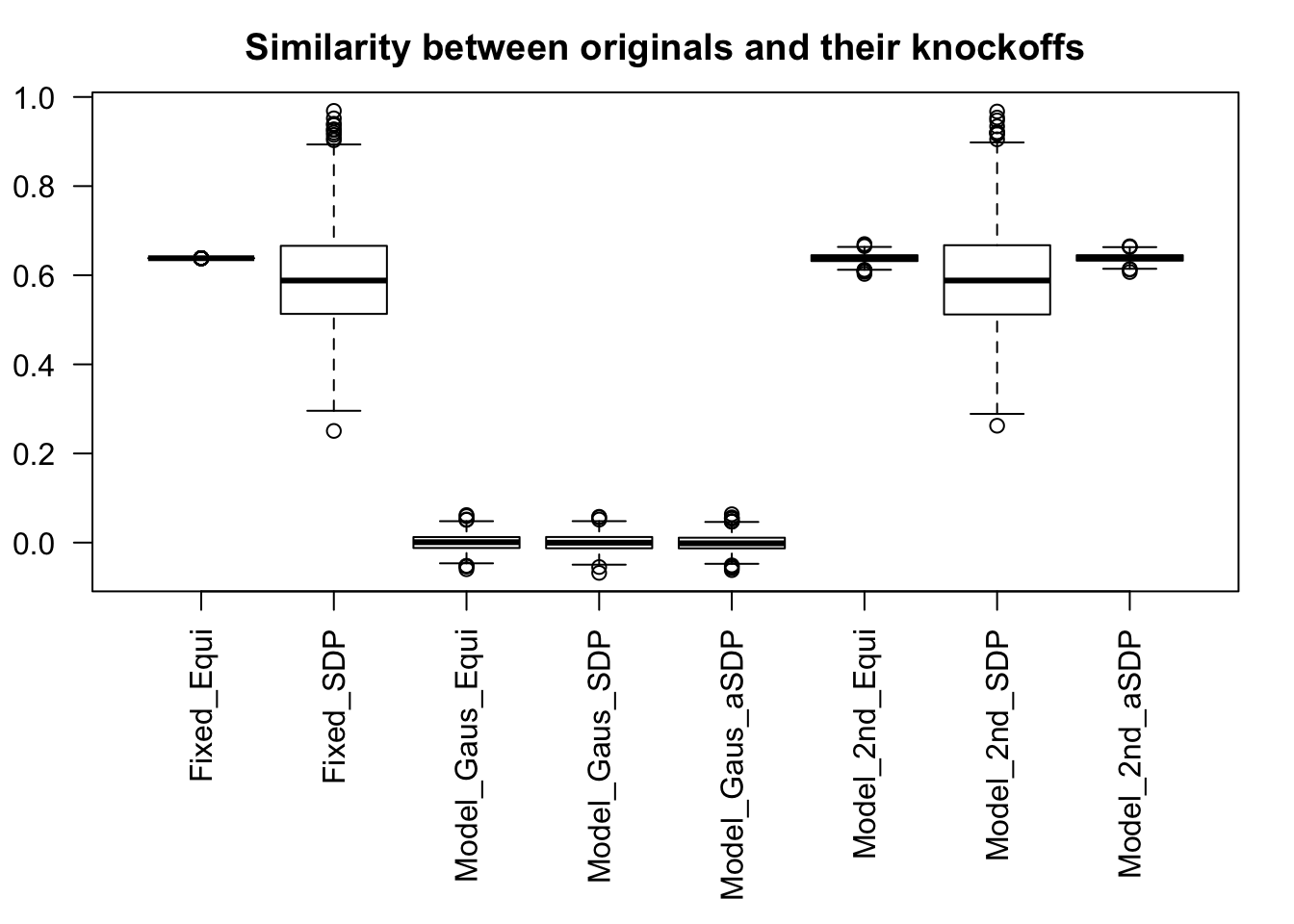
Expand here to see past versions of unnamed-chunk-3-5.png:
| Version | Author | Date |
|---|---|---|
| 480666b | LSun | 2018-03-03 |
Fixed Design

Expand here to see past versions of unnamed-chunk-4-1.png:
| Version | Author | Date |
|---|---|---|
| d3d259c | LSun | 2018-03-10 |
| 480666b | LSun | 2018-03-03 |
| 7b67910 | LSun | 2018-03-02 |

Expand here to see past versions of unnamed-chunk-4-2.png:
| Version | Author | Date |
|---|---|---|
| d3d259c | LSun | 2018-03-10 |
| 480666b | LSun | 2018-03-03 |
| 7b67910 | LSun | 2018-03-02 |

Model-\(X\) Design

Expand here to see past versions of unnamed-chunk-5-1.png:
| Version | Author | Date |
|---|---|---|
| d3d259c | LSun | 2018-03-10 |
| 480666b | LSun | 2018-03-03 |
| 7b67910 | LSun | 2018-03-02 |

Expand here to see past versions of unnamed-chunk-5-2.png:
| Version | Author | Date |
|---|---|---|
| d3d259c | LSun | 2018-03-10 |
| 480666b | LSun | 2018-03-03 |
| 7b67910 | LSun | 2018-03-02 |

Scenario 2: Equal-correlation
\[ \begin{array}{c} X_{ij} \sim N\left(0, \left(\frac{1}{\sqrt n}\right)^2\right) \\ cor(X_{ij}, X_{ij'}) \equiv \rho \end{array} \]
\(\rho = 0.5\)

Expand here to see past versions of unnamed-chunk-6-1.png:
| Version | Author | Date |
|---|---|---|
| d3d259c | LSun | 2018-03-10 |
| 480666b | LSun | 2018-03-03 |
| 7b67910 | LSun | 2018-03-02 |

Expand here to see past versions of unnamed-chunk-6-2.png:
| Version | Author | Date |
|---|---|---|
| d3d259c | LSun | 2018-03-10 |
| 480666b | LSun | 2018-03-03 |
| 7b67910 | LSun | 2018-03-02 |

Expand here to see past versions of unnamed-chunk-6-3.png:
| Version | Author | Date |
|---|---|---|
| d3d259c | LSun | 2018-03-10 |
| 480666b | LSun | 2018-03-03 |
| 7b67910 | LSun | 2018-03-02 |

Expand here to see past versions of unnamed-chunk-6-4.png:
| Version | Author | Date |
|---|---|---|
| d3d259c | LSun | 2018-03-10 |
| 7b67910 | LSun | 2018-03-02 |

Expand here to see past versions of unnamed-chunk-6-5.png:
| Version | Author | Date |
|---|---|---|
| d3d259c | LSun | 2018-03-10 |
Fixed Design

Expand here to see past versions of unnamed-chunk-7-1.png:
| Version | Author | Date |
|---|---|---|
| d3d259c | LSun | 2018-03-10 |
| 480666b | LSun | 2018-03-03 |
| 7b67910 | LSun | 2018-03-02 |

Expand here to see past versions of unnamed-chunk-7-2.png:
| Version | Author | Date |
|---|---|---|
| d3d259c | LSun | 2018-03-10 |
| 480666b | LSun | 2018-03-03 |
| 7b67910 | LSun | 2018-03-02 |

\(\rho = 0.99\)

Expand here to see past versions of unnamed-chunk-9-1.png:
| Version | Author | Date |
|---|---|---|
| d3d259c | LSun | 2018-03-10 |
| 480666b | LSun | 2018-03-03 |

Expand here to see past versions of unnamed-chunk-9-2.png:
| Version | Author | Date |
|---|---|---|
| d3d259c | LSun | 2018-03-10 |
| 480666b | LSun | 2018-03-03 |

Expand here to see past versions of unnamed-chunk-9-3.png:
| Version | Author | Date |
|---|---|---|
| d3d259c | LSun | 2018-03-10 |
| 480666b | LSun | 2018-03-03 |

Expand here to see past versions of unnamed-chunk-9-4.png:
| Version | Author | Date |
|---|---|---|
| d3d259c | LSun | 2018-03-10 |
| 480666b | LSun | 2018-03-03 |
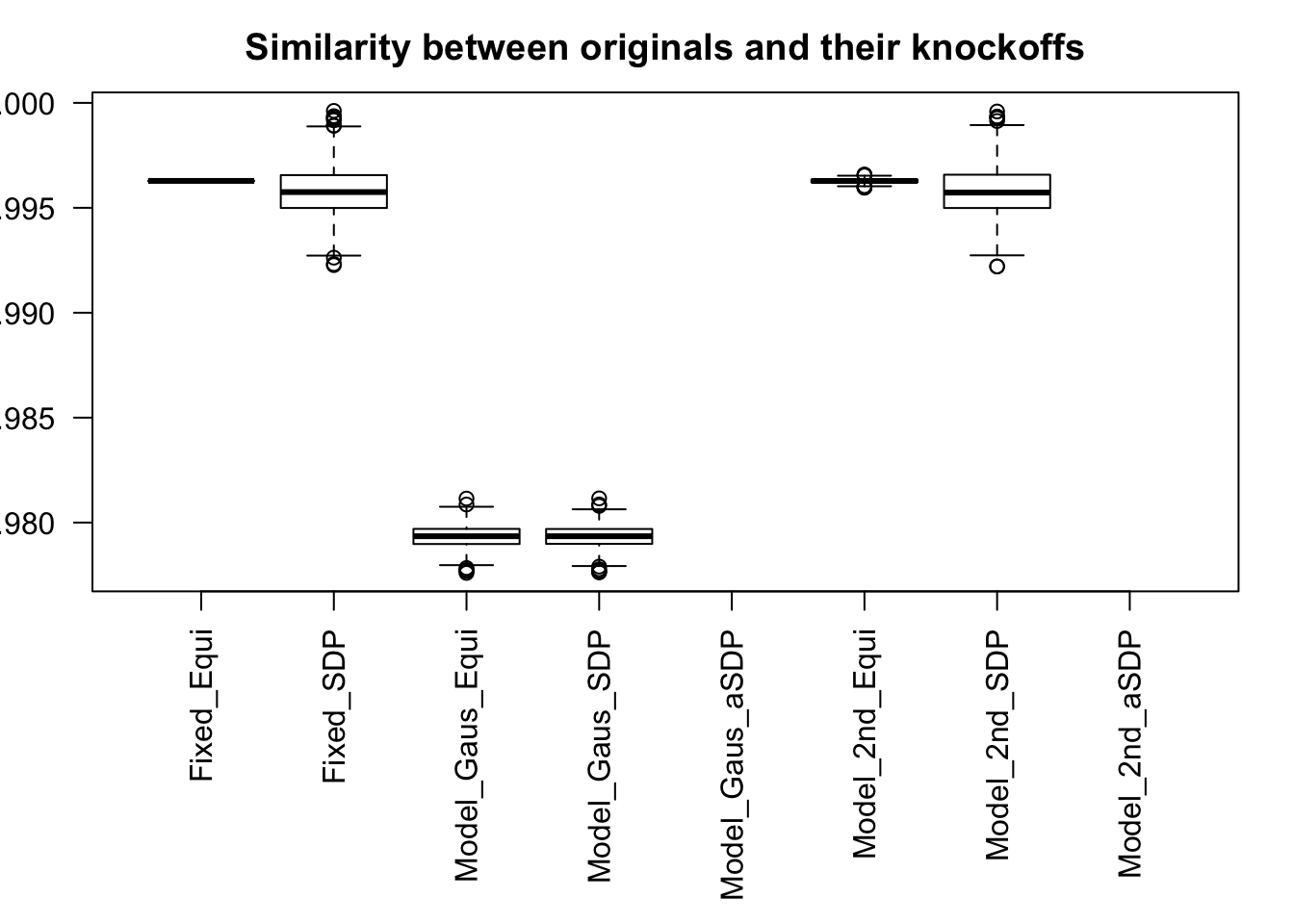
Expand here to see past versions of unnamed-chunk-9-5.png:
| Version | Author | Date |
|---|---|---|
| d3d259c | LSun | 2018-03-10 |
| 480666b | LSun | 2018-03-03 |
Fixed Design

Expand here to see past versions of unnamed-chunk-10-1.png:
| Version | Author | Date |
|---|---|---|
| d3d259c | LSun | 2018-03-10 |
| 480666b | LSun | 2018-03-03 |

Expand here to see past versions of unnamed-chunk-10-2.png:
| Version | Author | Date |
|---|---|---|
| d3d259c | LSun | 2018-03-10 |
| 480666b | LSun | 2018-03-03 |

Scenario 3: Extreme local correlation
\[ \begin{array}{c} X_{ij} \sim N\left(0, \left(\frac{1}{\sqrt n}\right)^2\right) \\ cor(X_{i1}, X_{i2}) = cor(X_{i3}, X_{i4}) = \cdots = cor(X_{i(p-1)}, X_{ip}) = \rho = 0.99 \end{array} \]

Expand here to see past versions of unnamed-chunk-12-1.png:
| Version | Author | Date |
|---|---|---|
| d3d259c | LSun | 2018-03-10 |
| 480666b | LSun | 2018-03-03 |

Expand here to see past versions of unnamed-chunk-12-2.png:
| Version | Author | Date |
|---|---|---|
| d3d259c | LSun | 2018-03-10 |
| 480666b | LSun | 2018-03-03 |

Expand here to see past versions of unnamed-chunk-12-3.png:
| Version | Author | Date |
|---|---|---|
| d3d259c | LSun | 2018-03-10 |
| 480666b | LSun | 2018-03-03 |

Expand here to see past versions of unnamed-chunk-12-4.png:
| Version | Author | Date |
|---|---|---|
| d3d259c | LSun | 2018-03-10 |
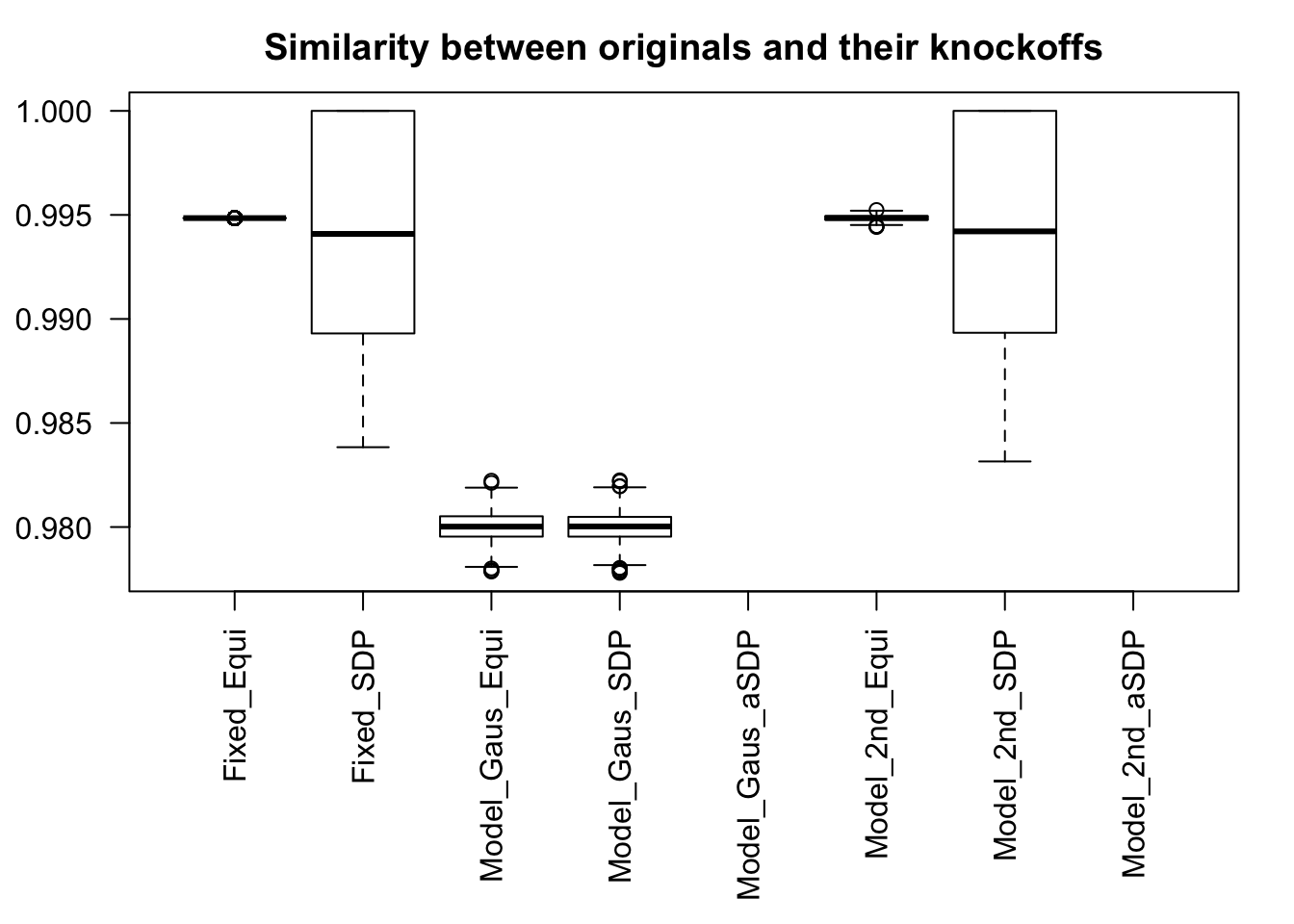
Expand here to see past versions of unnamed-chunk-12-5.png:
| Version | Author | Date |
|---|---|---|
| d3d259c | LSun | 2018-03-10 |
Fixed Design

Expand here to see past versions of unnamed-chunk-13-1.png:
| Version | Author | Date |
|---|---|---|
| d3d259c | LSun | 2018-03-10 |
| 480666b | LSun | 2018-03-03 |

Expand here to see past versions of unnamed-chunk-13-2.png:
| Version | Author | Date |
|---|---|---|
| d3d259c | LSun | 2018-03-10 |
| 480666b | LSun | 2018-03-03 |

Scenario 4: Factor Model for \(X\)
\[ \begin{array}{c} \text{each row }X_{i}^T \sim N\left(0, \frac{1}n\Sigma_{p}\right) \\ \Sigma_p = \texttt{cov2cor}(B_{p \times d}B_{d\times p}^T + I)\\ B_{ij} \overset{iid}{\sim} N(0, 1) \end{array} \]

Expand here to see past versions of unnamed-chunk-15-1.png:
| Version | Author | Date |
|---|---|---|
| d3d259c | LSun | 2018-03-10 |

Expand here to see past versions of unnamed-chunk-15-2.png:
| Version | Author | Date |
|---|---|---|
| d3d259c | LSun | 2018-03-10 |

Expand here to see past versions of unnamed-chunk-15-3.png:
| Version | Author | Date |
|---|---|---|
| d3d259c | LSun | 2018-03-10 |

Expand here to see past versions of unnamed-chunk-15-4.png:
| Version | Author | Date |
|---|---|---|
| d3d259c | LSun | 2018-03-10 |
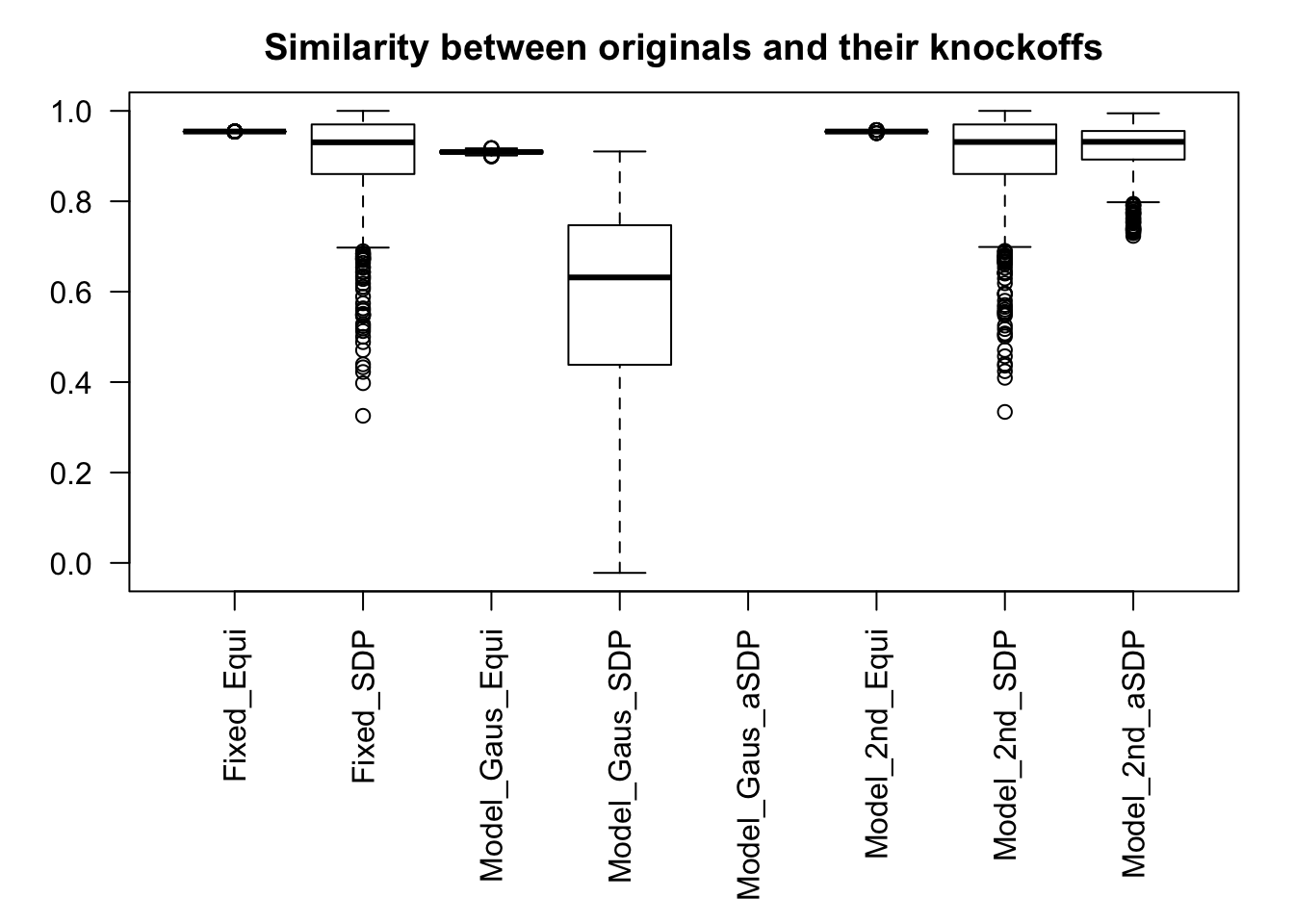
Expand here to see past versions of unnamed-chunk-15-5.png:
| Version | Author | Date |
|---|---|---|
| d3d259c | LSun | 2018-03-10 |
Fixed Design

Expand here to see past versions of unnamed-chunk-16-1.png:
| Version | Author | Date |
|---|---|---|
| d3d259c | LSun | 2018-03-10 |

Expand here to see past versions of unnamed-chunk-16-2.png:
| Version | Author | Date |
|---|---|---|
| d3d259c | LSun | 2018-03-10 |

Expand here to see past versions of unnamed-chunk-16-3.png:
| Version | Author | Date |
|---|---|---|
| d3d259c | LSun | 2018-03-10 |
Model-\(X\) Design

Expand here to see past versions of unnamed-chunk-17-1.png:
| Version | Author | Date |
|---|---|---|
| d3d259c | LSun | 2018-03-10 |

Expand here to see past versions of unnamed-chunk-17-2.png:
| Version | Author | Date |
|---|---|---|
| d3d259c | LSun | 2018-03-10 |

Expand here to see past versions of unnamed-chunk-17-3.png:
| Version | Author | Date |
|---|---|---|
| d3d259c | LSun | 2018-03-10 |
Scenario 5: Factor Model for \(\hat\beta\)
\[ \begin{array}{c} \text{each row }X_{i}^T \sim N\left(0, \frac{1}n\Sigma_{p}\right) \\ \Sigma_p = \texttt{cov2cor}(\left(B_{p \times d}B_{d\times p}^T + I\right)^{-1})\\ B_{ij} \overset{iid}{\sim} N(0, 1) \end{array} \]

Expand here to see past versions of unnamed-chunk-18-1.png:
| Version | Author | Date |
|---|---|---|
| d3d259c | LSun | 2018-03-10 |

Expand here to see past versions of unnamed-chunk-18-2.png:
| Version | Author | Date |
|---|---|---|
| d3d259c | LSun | 2018-03-10 |

Expand here to see past versions of unnamed-chunk-18-3.png:
| Version | Author | Date |
|---|---|---|
| d3d259c | LSun | 2018-03-10 |

Expand here to see past versions of unnamed-chunk-18-4.png:
| Version | Author | Date |
|---|---|---|
| d3d259c | LSun | 2018-03-10 |
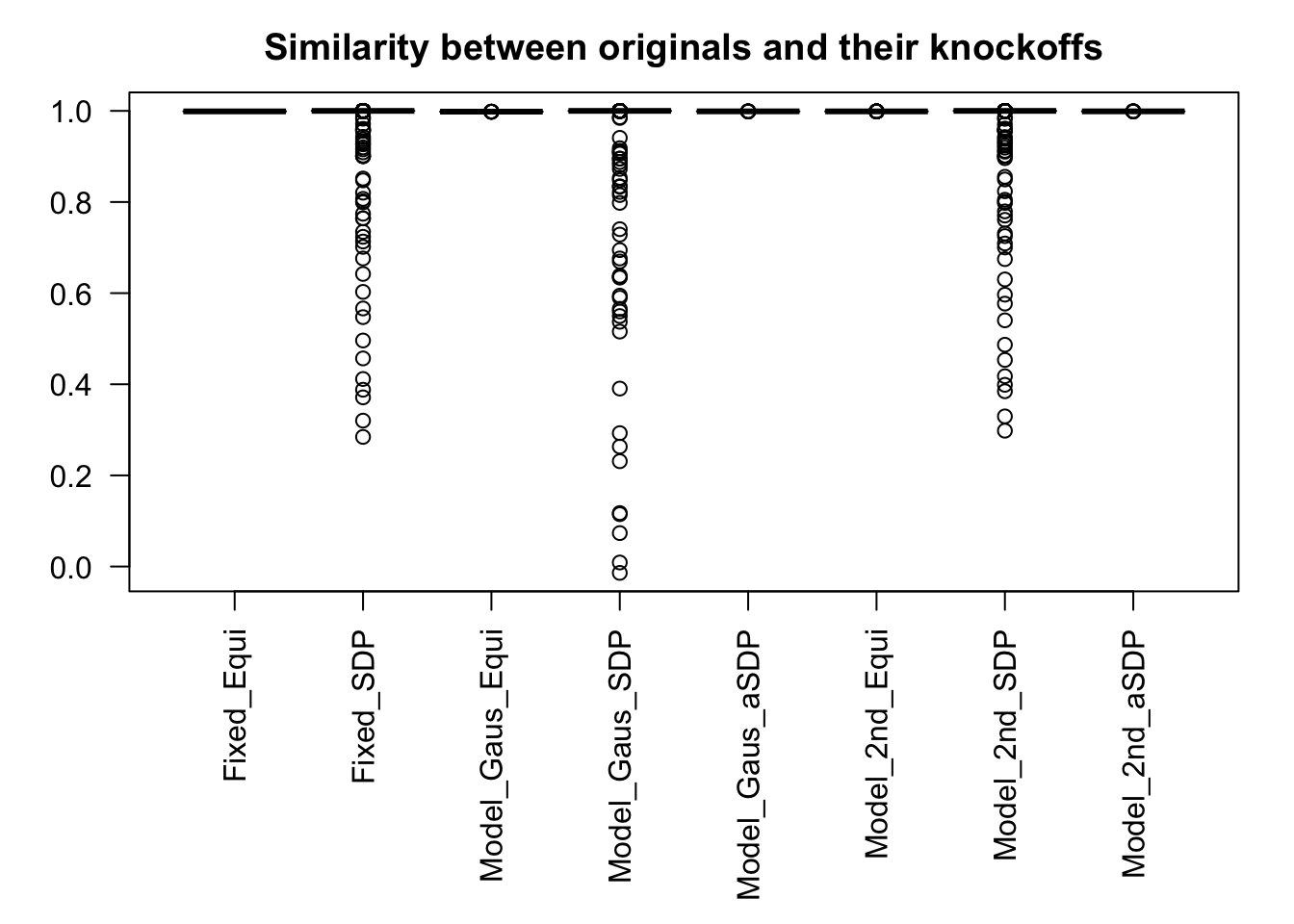
Expand here to see past versions of unnamed-chunk-18-5.png:
| Version | Author | Date |
|---|---|---|
| d3d259c | LSun | 2018-03-10 |
Fixed Design

Expand here to see past versions of unnamed-chunk-19-1.png:
| Version | Author | Date |
|---|---|---|
| d3d259c | LSun | 2018-03-10 |

Expand here to see past versions of unnamed-chunk-19-2.png:
| Version | Author | Date |
|---|---|---|
| d3d259c | LSun | 2018-03-10 |

Expand here to see past versions of unnamed-chunk-19-3.png:
| Version | Author | Date |
|---|---|---|
| d3d259c | LSun | 2018-03-10 |
Model-\(X\) Design

Expand here to see past versions of unnamed-chunk-20-1.png:
| Version | Author | Date |
|---|---|---|
| d3d259c | LSun | 2018-03-10 |

Expand here to see past versions of unnamed-chunk-20-2.png:
| Version | Author | Date |
|---|---|---|
| d3d259c | LSun | 2018-03-10 |

Expand here to see past versions of unnamed-chunk-20-3.png:
| Version | Author | Date |
|---|---|---|
| d3d259c | LSun | 2018-03-10 |
Observation
Model-\(X\) knockoff indeed increases power substantially.
Reason 1: it builds better knockoffs as they are less similar to originals, since Model-\(X\) is about population correlation not sample correlation.
Reason 2: Model-\(X\) unleashes a large swarm of complicated test statistics which are not applicable for Fixed-\(X\).
However, for that particular case when we have \[\Sigma_\hat\beta\] as a factor model, Model-\(X\) knockoffs are still not good.
Session information
sessionInfo()R version 3.4.3 (2017-11-30)
Platform: x86_64-apple-darwin15.6.0 (64-bit)
Running under: macOS High Sierra 10.13.4
Matrix products: default
BLAS: /Library/Frameworks/R.framework/Versions/3.4/Resources/lib/libRblas.0.dylib
LAPACK: /Library/Frameworks/R.framework/Versions/3.4/Resources/lib/libRlapack.dylib
locale:
[1] en_US.UTF-8/en_US.UTF-8/en_US.UTF-8/C/en_US.UTF-8/en_US.UTF-8
attached base packages:
[1] parallel stats graphics grDevices utils datasets methods
[8] base
other attached packages:
[1] lattice_0.20-35 doMC_1.3.5 iterators_1.0.9 foreach_1.4.4
[5] ggplot2_2.2.1 reshape2_1.4.3 Matrix_1.2-12 knockoff_0.3.0
loaded via a namespace (and not attached):
[1] Rcpp_0.12.16 compiler_3.4.3 pillar_1.0.1
[4] git2r_0.21.0 plyr_1.8.4 workflowr_1.0.1
[7] R.methodsS3_1.7.1 R.utils_2.6.0 tools_3.4.3
[10] digest_0.6.15 evaluate_0.10.1 tibble_1.4.1
[13] gtable_0.2.0 rlang_0.1.6 yaml_2.1.18
[16] stringr_1.3.0 knitr_1.20 rprojroot_1.3-2
[19] grid_3.4.3 rmarkdown_1.9 magrittr_1.5
[22] whisker_0.3-2 backports_1.1.2 scales_0.5.0
[25] codetools_0.2-15 htmltools_0.3.6 colorspace_1.3-2
[28] labeling_0.3 stringi_1.1.6 lazyeval_0.2.1
[31] munsell_0.4.3 R.oo_1.21.0
This reproducible R Markdown analysis was created with workflowr 1.0.1








